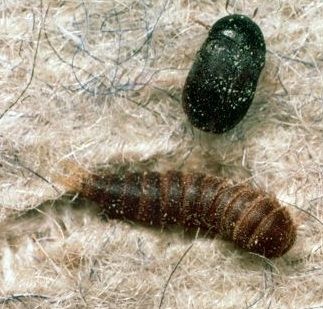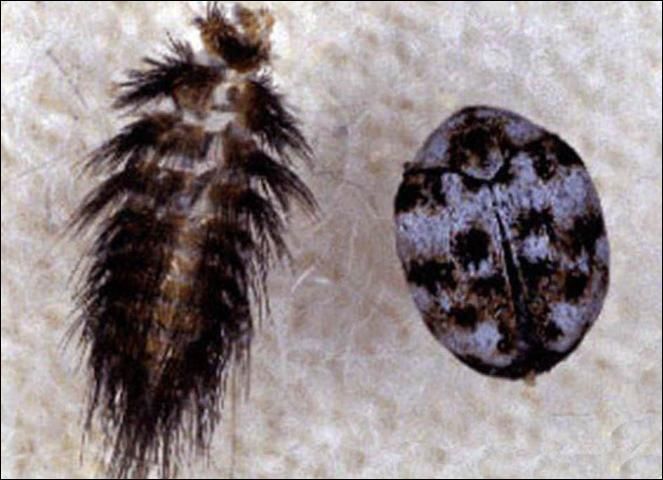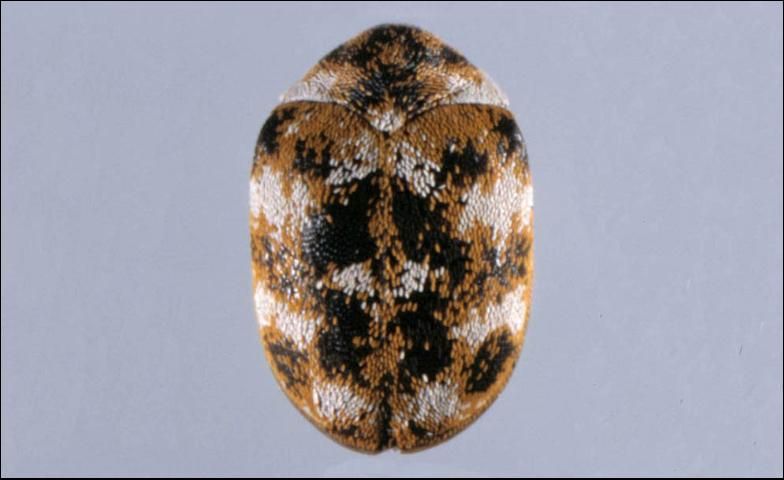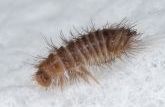
Credit: UF/IFAS
Carpet beetles are in the family Dermestidae, which includes species that feed on several dry animal and plant products. Carpet beetles can damage fabrics, furnishings and clothing that contain natural animal fibers such as wool, silk, hair, bristles, fur or feathers. Synthetic items are resistant to attack, but mixtures of synthetic and natural fibers can be damaged. The natural habitats of carpet beetles are nests of birds, rodents, insects, and spiders. From these locations, they can spread into homes to damage carpets, rugs, and clothing. They also may feed on pollen and can be carried into the house on cut flowers.
The black carpet, common carpet, furniture carpet, and varied carpet beetles usually infest fabrics and carpets and are the important pests in this group.
Life Cycle
The life cycle of carpet beetles can take from three months to two years. The adult female beetles lay up to 100 eggs, which hatch into larvae in one to two weeks. The larvae can develop under a wide range of temperature and humidity conditions. They tend to avoid light and actively feed in dark cracks, crevices, or folds. Most frequently they are found in the closets, drawers, or inside upholstered furniture. A larva requires from nine months to as much as three years to complete its growth, depending upon climatic conditions and food. The larvae wander considerably and may be found anywhere in a building. The presence of carpet beetle larvae can be detected by shed skin fragments and fecal pellets, which are about the size of a grain of salt, found around areas where they have been feeding. Adults are attracted to light and often are found on windows or around flowers.
Black Carpet Beetle
Black carpet beetle adults (Figure 1) are 1/8 to 1/4 (3-6 mm) inch in length and black with brown legs. The larva is slightly less than 3/8 inch (10 mm) in length, with a narrow, carrot-shaped body covered with short hairs, and has long terminal bristles. The black carpet beetle's life cycle is 180 to 650 days.

Credit: CC By 3.0 Clemson University—USDA Cooperative Extensions Sllide Series, Bugwood.org
These beetles are found nesting in carpeting, clothing, furs, upholstered furniture, leather goods, books, bird nests, milk powders, and other articles containing animal products and natural fibers. It is also commonly found eating pollen.
Common Carpet Beetle
Common carpet beetle adults (Figure 2) are about 1/8 (3 mm) inch in length and gray to black with whitish and orange scales on the back. The larva is carrot-shaped, reddish brown, and has many black to brown hairs. The common carpet beetle's life cycle is 77 to 110 days.

Credit: CC BY 3.0 Joseph Berger, Bugwood.org

Credit: CC BY 3.0 Joseph Berger, Bugwood.org
Common carpet beetles are found in fabrics, furnishings, processed foods, and clothing containing animal products such as wool, silk, hair, bristles, fur and feathers.
Furniture Carpet Beetle
Furniture carpet beetle adults (Figure 3) are about 1/8 inch (3 mm) in length with yellow, white, and black scales dorsally, and white scales ventrally. The larva (Figure 3) is about 3/16 inch (5 mm) long, carrot-shaped, and dark red to brown. The furniture carpet beetle's life cycle is 149 to 422 days.

Credit: CC BY 3.0 Joseph Berger, Bugwood.org
These beetles are common pests of woolen upholstered furniture and are found feeding on padding made of feathers or hair, as well as materials containing animal products and natural fibers. Fabrics made of cotton, linen and rayon, if stained with animal body oils, provide attractive food sources for beetle larvae to feed on.
Varied Carpet Beetle
Varied carpet beetle adults (Figure 4a) are about 1/8 inch (3 mm) in length with a dark body covered with white, brown and yellowish scales dorsally and grayish-yellow scales ventrally. In some older adult beetles, the scales that form the color patterns will wear off. Therefore, the beetles appear solid brown or black. The larva (Figure 4b) is about 3/16 (5 mm) inch in length and carrot-shaped, with alternating light and dark brown transverse stripes. The larvae of varied carpet beetles are distinguished from other carpet beetle larvae by their broader shape in the rear and narrower shape towards front of the larvae. The varied carpet beetle's life cycle is 249 to 354 days.
Varied carpet beetles are found in carpets, woolen goods, furs, stuffed animals, dried plant products, silks, and other materials containing animal products and natural fibers. Outdoors, adult female beetles will search for spider webs and bee, wasp and bird nests that contain eggs. The nests contain dead insects, pollen and other debris that can serve as larval food.

Credit: Lyle J. Buss, UF/IFAS

Credit: CC BY 3.0 Joseph Berger, Bugwood.org
Control
Prevention
The most damaging stage of carpet beetles is the larval stage. Because carpet beetle larvae can feed on dust and lint, good housekeeping can prevent infestations. Frequent cleaning of floors to remove dust and lint eliminates much of the available food supply, and some of the carpet beetles. However, regular cleaning will not remove dust and lint from air conditioning ducts and other inaccessible areas. Carpet beetles are among the most difficult indoor pests to control because of their ability to find food sources in obscure places, and they tend to disperse and cover large areas in a building. Regularly washing clothes and dry cleaning garments that cannot be cleaned in washing machines not only remove oils and stains, they will also kill carpet beetles.
Stored materials subject to beetle damage should be thoroughly cleaned before storage. Materials should be stored in a chest, closet, or other container that can be tightly closed, and in which moth balls or flakes can be used. These products are usually labeled to be placed at the rate of 1 pound per 50 cubic feet of space. The initial treatment should kill the carpet beetles. However, this method should not be relied upon to protect stored fabrics over an extended period of several months or more. Stored materials should be periodically sunned and brushed. Cedar chests will not kill carpet beetles.
Inspection
A thorough inspection is crucial in finding sources of carpet beetle infestations. Although carpet beetles damage fabrics in a house, they may also be found in nests built by sparrows, starlings, or pigeons on or inside the house. Carpet beetles can also be brought in on cut flowers. Wasp nests under eaves or in attics are also common sources of carpet beetles because the larvae will feed on the skins and larvae of wasps. Dead insects in attics or inaccessible areas may also be an important reservoir of infestation, as may be accumulations of debris in ventilation ducts in the house. Upon first inspection, it is not always possible to discern from damaged fabrics whether the damage was caused by clothes moths or carpet beetles. However, carpet beetles tend to damage a larger area on one portion of a garment or carpet, while clothes moths' damage often appears as scattered holes.
Nonchemical Control
Adult carpet beetles can be captured on sticky fly paper baited with animal products and/or appropriate pheromones. Cedar products can be used to protect susceptible items. Newly hatched larvae die when exposed to cedar, but older larvae and adults are not affected. The heartwood of red cedar has a vapor that is toxic to larvae, but after cedar is more than 36 months old it is useless for control. Bags containing cedar chips should be replaced regularly to help provide control.
Plastic bags and tight containers can be used to store garments. These containers prevent adult beetles from laying eggs on or near susceptible clothing. However, if the clothing is infested, the bags will confine the infestation to just a few items.
Cold storage has been long used to protect articles attacked by carpet beetles. Clothing, coats, and sweaters stored at 40°F to 42°F (4.5°C-5.5°C) will be protected for long periods of time. Freezing has also been used to kill carpet beetles. Infested materials should be placed in plastic bags and loosely packed in a chest freezer at -20°F (-30°C) for three days. Reducing the air in the bag eliminates the formation of ice. Heat has also been used to kill or repel carpet beetle larvae. Exposure of infested items to 105°F for four hours is sufficient. Exposing infested items to hot sunlight causes larvae to abandon the fabric.
Chemical Control
Good housekeeping practices are the best strategy for carpet beetle management. Indoor spot or surface treatment with insecticides can provide effective control of carpet beetles, although more than one application may be necessary. In most cases, direct spray of clothing should be avoided. Surfaces where clothes are stored can be sprayed and allowed to dry. Then clothes can be placed on those surfaces. When spraying or dusting rugs, closet areas, and storage areas, be sure to treat all known or suspected feeding and hiding places. Carpet beetles leaving the infested products will contact the sprayed surfaces and die.
Space sprays are also effective in killing exposed stages of carpet beetles. These are most effective when an infestation is confined to a closet or other enclosed area. Calculate the volume of the space and treat with the recommended amounts of product. In cases where entire homes are infested, fumigation can be used. Dust formulations can be used for treating attics, wall voids, and other inaccessible places. Some dust formulations may cause adverse reactions to people with respiratory problems. Therefore, read and follow label precautions carefully. Resin (pest) strips containing volatile, low-molecular-weight pesticides may also be used in enclosed containers to help control adult carpet beetles. One strip should be used per 1,000 cubic feet (30 m3) of container space and replaced after three months. For this treatment to be effective, the container must stay sealed. Aeration will disrupt this treatment.